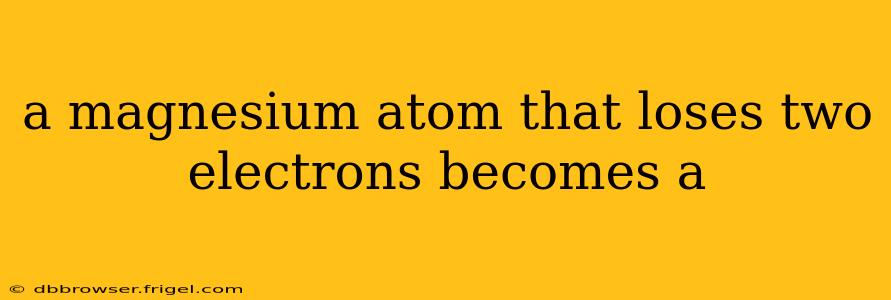A Magnesium Atom That Loses Two Electrons Becomes a Magnesium Ion (Mg²⁺)
A magnesium atom that loses two electrons transforms into a magnesium ion, specifically a magnesium cation denoted as Mg²⁺. This is a fundamental concept in chemistry, understanding which is crucial for grasping the behavior of elements and their interactions. Let's delve deeper into the process and related concepts.
What Happens When a Magnesium Atom Loses Electrons?
Magnesium (Mg) is an alkaline earth metal located in Group 2 of the periodic table. A neutral magnesium atom possesses 12 electrons, mirroring its 12 protons, resulting in a net charge of zero. These electrons are arranged in energy levels or shells: two in the first shell, eight in the second, and two in the outermost or valence shell. It's this outermost shell, containing two loosely bound electrons, that's responsible for magnesium's reactivity.
When magnesium interacts with other atoms, particularly highly electronegative atoms like oxygen or chlorine, it readily loses these two valence electrons. This loss isn't a simple expulsion; rather, it's a transfer driven by the desire to achieve a stable electron configuration, resembling that of a noble gas (in this case, neon). Losing these two electrons leaves the magnesium atom with 10 electrons and 12 protons, resulting in a net positive charge of +2.
Why Does Magnesium Lose Two Electrons?
Magnesium's tendency to lose two electrons stems from the principle of achieving the most stable electron configuration possible. By losing these two electrons, magnesium attains a filled outer electron shell, a state of lower energy and greater stability. This stable octet configuration mirrors that of noble gases, known for their chemical inertness. This process is referred to as ionization.
What are Cations and Anions?
The process of losing or gaining electrons results in the formation of ions.
- Cations: Positively charged ions formed when an atom loses electrons (like Mg²⁺). The positive charge arises because the number of protons exceeds the number of electrons.
- Anions: Negatively charged ions formed when an atom gains electrons. The negative charge stems from an excess of electrons compared to protons.
Magnesium, being a metal, readily forms cations, while nonmetals generally form anions.
What are some common uses of Magnesium Ions?
Magnesium ions (Mg²⁺) play vital roles in numerous biological and chemical processes. They are essential for:
- Biological processes: Mg²⁺ is an important cofactor in many enzyme reactions within living organisms, influencing crucial functions such as muscle contraction, nerve impulse transmission, and protein synthesis.
- Chemical reactions: Magnesium salts are used extensively in various chemical processes, acting as catalysts or reactants in various applications.
- Materials science: Magnesium alloys are used due to their lightweight and strong properties.
How does the loss of electrons affect the size of the magnesium atom?
When a magnesium atom loses its two valence electrons to become a Mg²⁺ ion, its size decreases significantly. This is because the remaining electrons are held more tightly by the nucleus, due to the increased effective nuclear charge. The positive charge of the nucleus is now stronger relative to the number of electrons.
In summary, a magnesium atom that loses two electrons transforms into a magnesium ion (Mg²⁺), a cation with a +2 charge, owing to the loss of negatively charged electrons. This transformation is crucial in understanding the chemical behavior of magnesium and its vital role in various biological and industrial applications.
